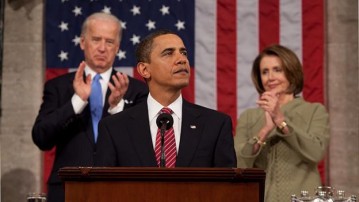Regardless of your political leanings, it’s hard to dispute the fact that President Obama is a very gifted public speaker. He brings Moms, Grandmas and Jesse Jackson to tears, he makes babies immediately stop crying by holding them, he makes ladies swoon when he smiles… but we digress. Last Tuesday was Mr. Obama’s annual State of the Union, and despite the dense material, he didn’t disappoint. Here are five tips you can learn from it.
1. Speak from personal experience.
“My grandfather, a veteran of Patton’s Army, got the chance to go to college on the GI Bill. My grandmother, who worked on a bomber assembly line, was part of a workforce that turned out the best products on Earth. The two of them shared the optimism of a nation that had triumphed over a depression and fascism.”
Connect with your audience by giving them a little bit of yourself. Relate to them. Tell them why they should listen to you. Explain to them why they should trust you. Be honest. Avoid the isolation of being an authoritative stranger at the front of the room. When speaking of hardship, tell them the story of how you became successful despite your impoverished background. You’ll be remembered for that story because the audience learned something about you. When Mr. Obama tells a story about himself he becomes more real and accessible to us. He becomes less like the President and more like the guy next door. He has a grandfather and a grandmother, just like the rest of us. Make yourself well rounded and interesting.
2. Tell stories.
“Jackie Bray is a single mom from North Carolina who was laid off from her job as a mechanic. Then Siemens opened a gas turbine factory in Charlotte, and formed a partnership with Central Piedmont Community College. The company helped the college design courses in laser and robotics training. It paid Jackie’s tuition, then hired her to help operate their plant.”
People are natural storytellers. We like to hear stories. We like to tell stories. We like to read stories. We’re much more likely to understand, empathize and remember a point if we’re told a story. Rather than saying “I love dogs,” tell the story of when you found a dog on the side of the road in the rain and brought it home to love and take care of. That pulls at your audience’s heartstrings. Remember the old adage: Show, don’t tell. Stories evoke images in the audience’s mind and put a human face on complex situations. When Mr. Obama relates Jackie’s experience, it cuts through all the complex political jargon and puts a human face on the abstract notion of job creation.
3. Be funny.
“We got rid of one rule from 40 years ago that could have forced some dairy farmers to spend $10,000 a year proving that they could contain a spill– because milk was somehow classified as an oil. With a rule like that, I guess it was worth crying over spilled milk.”
The State of the Union is generally a boring affair. It’s an hour-long slug through a long, detailed list of proposed policies, inflated accomplishments, and subtle jabs at the opposing party. Hopefully your presentation is inherently more interesting, but regardless if it is or not, take things lightly. Have a sense of humor. Mr. Obama’s joke about spilled milk isn’t particularly knee slapping, but it’s lighthearted fare in the midst of a whole lot of seriousness. No one is going to begrudge you for telling an unfunny joke. Rather, they’re going to smile kindly and move on (while secretly feeling relieved that it’s not them up there).
4. Use repetition.
“I will not walk away from the promise of clean energy. I will not walk away from workers like Bryan. I will not cede the wind or solar or battery industry to China or Germany because we refuse to make the same commitment here.”
Repetition is the easiest way to emphasize a point, and one of the most effective techniques in keeping the audience’s attention. Three is the magic number. Say something three times in three different ways, and it will stick. Also, employing the same beginning of a sentence, as Mr. Obama does here, is effective in its simplicity. I will not, I will not, I will not. It sounds good. It sounds powerful. It sounds effective. (See?)
5. End strongly.
“So it is with America. Each time I look at that flag, I’m reminded that our destiny is stitched together like those 50 stars and those 13 stripes. No one built this country on their own. This nation is great because we built it together. This nation is great because we worked as a team. This nation is great because we get each other’s backs. And if we hold fast to that truth, in this moment of trial, there is no challenge too great; no mission too hard. As long as we are joined in common purpose, as long as we maintain our common resolve, our journey moves forward, and our future is hopeful, and the state of our Union will always be strong. Thank you, God bless you, and God bless the United States of America.”
Leave your audience on the edge of their seats, leave them wanting more, leave them with goosebumps. People remember endings. So leave them with a memorable one. Choose something– whether that be a story, a quote or a fact– that will stay with the audience after you finish. Go out on your strongest note. Be epic.
